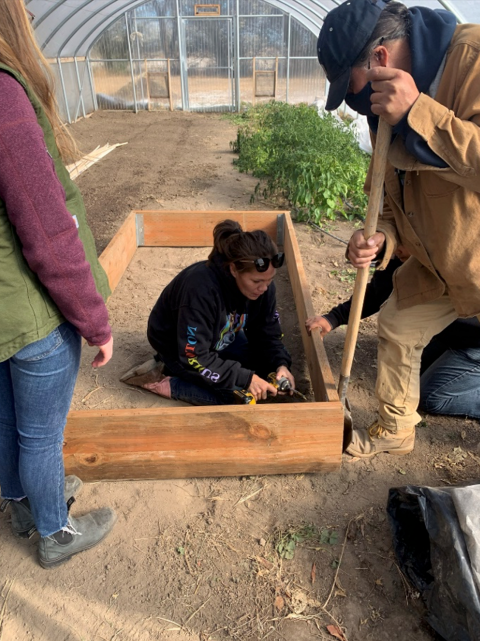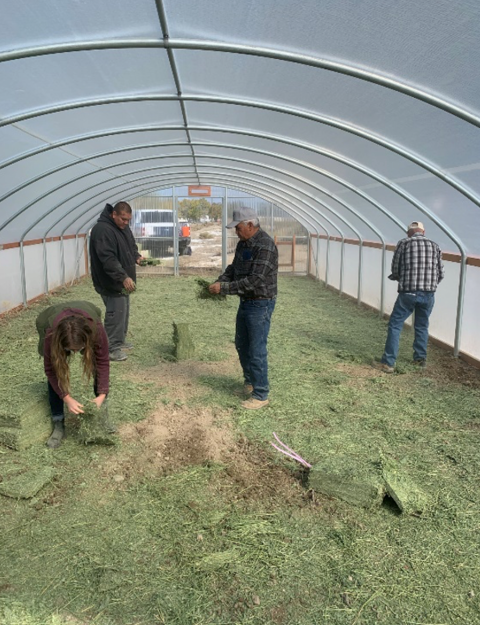Location













States
Idaho, NevadaEcosystem
Prairie, RuralIntroduction
Food deserts are areas where residents have limited access to affordable and nutritious food, often due to absence of well-stocked grocery stores or other sources of fresh produce. In the United States, food deserts are primarily driven by structural inequalities and “supermarket redlining,” where large supermarkets choose not to open stores in low-income areas (Zhang and Debarchana, 2015). Native American reservations are often located in food deserts, far from the nearest grocery store, with fast food restaurants and convenience stores being the only accessible and economical food choices for residents. Additionally, reservations are often intentionally located in areas with poor growing conditions for vegetables, including harsh weather and short growing seasons. After being forcibly displaced from their ancestral land and relocated onto these small reservations, many Native American Tribes have lost traditional knowledge about gardening and growing.
In response, the University of Nevada Cooperative Extension, in partnership with the National Institute of Food and Agriculture, Barrick Gold Corporation, and Native American Tribes across northern Nevada, initiated the Duck Valley Food Sovereignty Project, also known as the Hoop House Project. The goal of the Hoop House Project is to help Tribes improve the availability and consumption of nutritious food in their communities through building hoop houses and organizing regional training workshops about gardening and food production.
Hoop houses, simple greenhouse structures relying on passive solar heating and natural ventilation, protect plants from harsh growing conditions. Hoop houses are cost-effective and low-maintenance, making them accessible to small-scale growers. The first hoop house of the project was constructed at a school in partnership with the Shoshone-Paiute Tribes on Duck Valley Reservation, on the border of Idaho and Nevada. As of 2023, the project has constructed around 80 hoop houses on the Duck Valley Reservation. Five of these are community-maintained, and the rest belong to individual families, located in their backyards.
Key Issues Addressed
Economic and geographic barriers make it difficult for many residents on Native American reservations to access and purchase fresh fruits and vegetables. Tribes that are located in remote areas may have to travel up to 100 miles to buy fresh produce because they are far from full-service grocery stores and cannot afford to set up and maintain their own garden. This forces communities like Duck Valley to rely largely on less healthy, more processed foods stocked and sold cheaply in convenience stores.
The arid climate and environmental conditions of northern Nevada are challenging for growing food. The poor soils, fluctuating temperature, and high altitude can pose problems even for people with the financial and material resources to garden.
Over time, the practice of gardening, along with gathering, hunting, and fishing, declined among Nevada’s Tribal communities, due to loss of their traditional lands and resources after forced relocation and the imposition of reservation boundaries. This disruption of traditional subsistence practices limited the variety of available foods and resulted in people eating fewer fruits and vegetables. Reversing this trend will require reconnecting with and reinvesting in their heritage of subsistence gardening, a practice in which many Tribal members recall their elders participating.
Project Goals
The Hoop House Project aims to increase the amount of fresh produce available to families on the Duck Valley Reservation. By making healthy food options more accessible, the project seeks to empower residents to make healthier dietary choices, improving overall wellbeing in a community where obesity and diabetes levels are high.
In partnership with the University of Nevada Cooperative Extension, the Hoop House Project aims to provide material and educational resources to support construction and maintenance of productive gardens in hoop houses. In particular, the project works to help hoop house growers adapt to challenging conditions by facilitating access to arable soil and pest prevention tools.
The project encourages community youth, beginning as young as elementary school students, to participate in gardening and food production in their family hoop houses or community spaces. By involving the younger generation in these activities, the project not only imparts valuable skills and knowledge but also fosters a sense of ownership and reconnection to their food sources. This engagement and investment is crucial for nurturing a culture of food sovereignty where the community has control over its food systems, ensuring long-term resilience and sustainability.
Project Highlights
Sharing Garden Surplus: With good support and growing conditions, hoop houses can allow many families to share surplus with their community, continuing the valued tradition of sharing with others in times of abundance.
- Developing Hoop House Expertise: The Hoop House Project has trained dozens of participants in constructing and maintaining over 80 hoop houses. At the start, the project team provides labor to build the structures and materials such as soil and grow boxes. They also run workshops to train growers in techniques including transplanting and winter cover cropping. The project team returns to communities for regular check-ins to discuss growing strategies and address problems. For example, hoop house visits in 2021 included assistance with sowing winter rye to regenerate the soil outside of the traditional growing season.
- Expanding Interest: Participants in the Hoop House Project have developed skills and expertise in high demand, and teams of knowledgeable constructors have been contracted out to build hoop houses in neighboring areas. The project has gained considerable attention outside of Duck Valley for its effectiveness; several other Tribes in Nevada including the Southfork Tribe, the Elko Band, the Battle Mountain Band, the Yomba Tribe, and the Duckwater Tribe have received hoop houses. Further afield, communities in Arizona and Oregon have requested help building their own hoop houses.
- CARES Act Building Boom: After years of gradually building more hoop houses on the reservation to a total of 30, the CARES Act funding provided the means to build 50 new hoop houses in 2020. Scaling the project up was a challenge, but hiring extra temporary staff and a tremendous amount of community support made it possible.
- Community Education and Youth Engagement: The Hoop House Project team teaches all interested community members, especially youth, how to use the structures. Training topics include how to turn hard, rocky ground with lots of alkaline salt into arable land, and how to know when produce is ripe. Reaccessing this knowledge is crucial for reclaiming traditional food systems, strengthening cultural identity, and increasing food sovereignty moving forward in Duck Valley.
Lessons Learned
When selecting recipients for hoop houses, it is important to choose participants who will maintain engagement with the project. Individual families who received hoop houses have embraced the responsibility of ownership and have been able to maintain their gardens for many years. In contrast, plots operated by the Tribal government sometimes went untended due to employee turnover. Continued engagement with gardeners through check-in visits and training workshops has proven essential to ensuring long-term garden maintenance.
Investment in quality materials and infrastructure resulted in longer-lasting and more productive hoop houses. While some cheaper PVC models assembled by the team were easily damaged by the weather and required frequent repairs, prefab kits from Oregon Valley Greenhouses were sturdy and easy to assemble. Drip irrigation systems also pose an upfront cost, but the investment improves water efficiency in the gardens because they require less water and labor than watering by hand.
Preventative action is key to avoid pest problems. In 2022, gardeners in Owyhee struggled with an influx of Mormon crickets (Anabrus simplex). Despite mitigation attempts with poisoned bait, the infestation had progressed too far, and their plots were overrun. Next season, gardeners will focus on prevention. For example, placing physical barriers around plots inside a hoop house can stop swarms from invading crops. Gardeners can also build raised beds or grow boxes inside the hoop houses to protect crops from burrowing animals like ground squirrels (Urocitellus canus). Raised beds also allow gardeners to bring in higher quality soil for planting.
Next Steps
- During peak season, many hoop houses produce more food than a single family can consume. In autumn 2024, the project planned a community farmer’s market to sell surplus produce and provide an accessible source of fresh fruit and vegetables for the Duck Valley community. Funds raised will contribute to hoop house maintenance.
- In addition to maintaining existing garden infrastructure, the project will support construction of additional hoop houses for Tribal members who can provide materials and have the financial means. To expand participation, the project will seek grant funding to subsidize hoop house construction, and run home gardening workshops for individuals without hoop houses.
Funding Partners
- Nevada Gold Mines
- Indian Land Tenure Foundation
- University of Nevada Cooperative Extension
- National Institute of Food and Agriculture
- Barrick Gold Corporation
Resources
- Presentation: Shoshone-Paiute Tribes CARES Act Yr. 2020-21 Duck Valley Hoop House Project
- Report: Tribal Monitoring Hoop Houses Workshops, Winter Cover Crops and Transplant Education
- Video: Extension Native Programs Hoop House Project
- Reedster et al. (2013). “Unique Challenges Facing Southwestern Tribes.” In Assessment of Climate Change in the Southwest United States: A Report Prepared for the National climate Assessment, 385-404.
- Welsh (2022). “Indigenous Ingenuity: Priorities on the Duck Valley Indian Reservation: Fighting Cancer, Reviving Agriculture, and Keeping Native Languages Alive.” Reno News and Review.
- Zhang and Debarchana (2015). “Spatial Supermarket Redlining and Neighbourhood Vulnerability: A Case Study of Hartford, Connecticut.” Trans GIS, 20(1), 79-100.
Contact
Reggie Premo, University of Nevada Cooperative Extension, reginaldp@unr.edu
CART Lead Authors
- Annika Mayer, Native Climate Communications Designer, Desert Research Institute
- Erin Connolly, Drought Learning Network (DLN) Case Study Author
Suggested Citation
Mayer, A.C. & Connolly, E.E. (2024). “Growing food sovereignty with hoop houses on the Duck Valley Reservation.” CART. Retrieved from https://www.fws.gov/project/hoop-houses-duck-valley-reservation.
The DLN is a peer-to-peer knowledge exchange between climate service providers and resource managers, created to gather and share lessons learned from drought events to prepare for future events. The DLN partners with CART to develop Case Studies, with funding from the National Drought Mitigation Center for interns and coordination support from the USDA Southwest Climate Hub.






